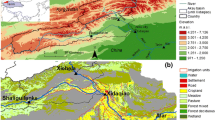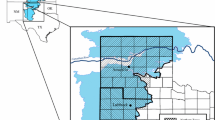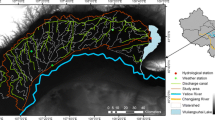Abstract
The Sina river basin is facing both episodic and chronic water shortages due to intensive irrigation development. The main objective of this study was to characterize the hydrologic processes of the Sina river basin and assess crop water productivity using the distributed hydrologic model, SWAT. In the simulation year (1998–1999), the inflow to reservoir from upstream side was the major contributor to the reservoir accounting for 92 % of the total required water release for irrigation purpose (119.5 Mm3), while precipitation accounted for 4.1 Mm3. Annual release of water for irrigation was 119.5 Mm3 out of which 54 % water was diverted for irrigation purpose, 26 % was wasted as conveyance loss, average discharge at the command outlet was estimated as 4 % and annual average ground-water recharge coefficient was in the range of 13–17 %. Various scenarios involving water allocation rule were tested with the goal of increasing economic water productivity values in the Sina Irrigation Scheme. Out of those, only most benefited allocation rule is analyzed in this paper. Crop yield varied from 1.98 to 25.9 t/ha, with the majority of the area between 2.14 and 2.78 t/ha. Yield and WP declined significantly in loamy soils of the irrigation command. Crop productivity in the basin was found in the lower range when compared with potential and global values. The findings suggested that there was a potential to improve further. Spatial variations in yield and WP were found to be very high for the crops grown during rabi season, while those were low for the crops grown during kharif season. The crop yields and WP during kharif season were more in the lower reach of the irrigation commands, where loamy soil is more concentrated. Sorghum in both seasons was most profitable. Sorghum fetched net income fivefold that of sunflower, two and half fold of pearl millet and one and half fold of mung beans as far as crop during kharif season were concerned and it fetched fourfold that of groundnut, threefold of wheat, twofold of onion during rabi season and was sevenfold of sugarcane. Analysis suggests that maximization of the area by provision of supplemental irrigation to rainfed areas as well as better on-farm water management practices can provide opportunities for improving water productivity.






Similar content being viewed by others
References
A. Gaur, S. Acharya, H. Turral, P.G. McCornick, Implications of drought and water regulation in the Krishna basin, India. Int. J. Water Resour. Dev. 23(4), 583–589 (2007)
J.W. Kijne, R. Barker, D. Molden, Water Productivity in Agriculture: Limits and Opportunities for Improvement (CAB International, Wallingford, 2003)
B.A.M. Bouman, A conceptual framework for the improvement of crop water productivity at different spatial scales. Agric. Syst. 93, 43–60 (2007)
D. Molden, Accounting for water use and productivity. In SWIM Paper 1. IIMI, Colombo (1997)
D. Molden, R. Sakthivadivel, Water accounting to assess use and productivity of water. Int. J. Water Resour. Dev. 15(1 and 2), 55–71 (1999)
R. Loeve, B. Dong, D. Molden, Y.H. Li, C.D. Chen, J.Z. Wang, Issues of scale in water productivity in the Zhanghe irrigation system: implications for irrigation in the basin context. Paddy Water Environ. 2(4), 227–236 (2004)
J.C. Refsgaard, B. Storm, MIKE SHE, in Computer models of watershed hydrology, ed. by V.P. Singh (Water Resources Publications, Highlands Ranch, 1995), pp. 809–846
S. Im, H. Kim, C. Kim, C. Jang, Assessing the impacts of land use changes on watershed hydrology using MIKE SHE. Environ. Geol. 57, 231–239 (2009)
K.J. Beven, M.J. Kirkby, A physically based, variable contributing area model of basin hydrology. Hydrol. Sci. Bull. 24(1), 43–69 (1979)
B. Vincendon, V. Ducrocq, G.M. Saulnier, L. Bouilloud, K. Chancibault, F. Habets, J. Noilhan, Benefit of coupling the ISBA land surface nodel with a TOPMODEL hydrological model version dedicated to Mediterranean flash-flood. J. Hydrol. 394(1–2), 256–266 (2010)
J.G. Arnold, P. Srinivasan, R.S. Muttiah, J.R. Williams, Large area hydrologic modeling and assessment. Part I. Model development. J. Am. Water Resour. Assoc. 34, 73–89 (1998)
R. Srinivasan, T.S. Ramanarayanan, J.G. Arnold, S.T. Bednarz, Large area hydrologic modeling and assessment part II: model application. J. Am. Water Resour. Assoc. 34, 91–101 (1998)
P. Ndomba, F. Mtalo, Killingtveit., SWAT model application in a data scarce tropical complex catchment in Tanzania. Phys. Chem. Earth 33(8–13), 626–632 (2008)
A. Stehr, P. Debels, F. Romero, H. Alcayaga, Hydrological modeling with SWAT under conditions of limited data availability: evaluation of results from a Chilean case study. Hydrol. Sci. J. 53(3), 588–601 (2008)
S. Dhar, A. Mazumdar, Hydrological modeling of Kangsabati River under changed climate scenario: case study in India. Hydrol. Proc. 23(16), 2394–2406 (2009)
A.K. Gosain, S. Rao, D. Basuray, Climate change impact assessment on hydrology of Indian river basins. Curr. Sci. 90(3), 346–353 (2006)
W.W. Immerzeel, P. Droogers, Calibration of a distributed hydrological model based on satellite evapotranspiration. J. Hydrol. 349(3–4), 411–424 (2008)
W.W. Immerzeel, A. Gaur, S.J. Zwart, Integrating remote sensing and a process-based hydrological model to evaluate water use and productivity in a south Indian catchment. Agric. Water Manag. 95(1), 11–24 (2008)
M.S. Kang, S.W. Park, J.J. Lee, K.H. Yoo, Applying SWAT for TMDL programs to a small watershed containing rice paddy fields. Agric. Water Manag. 79, 72–92 (2006)
C.H. Green, A.V. Griensven, Auto-calibration in hydrologic modeling: using SWAT2005 in small-scale watersheds. Environ. Model Softw. 23, 422–434 (2008)
Y. Luo, C. He, M. Sophocleous, Z. Yin, R. Hongrui, Z. Ouyang, Assessment of crop growth and soil water modules in SWAT2000 using extensive field experiment data in an irrigation district of the Yellow River Basin. J. Hydrol. 352, 139–156 (2008)
J. Schuol, K.C. Abbaspour, R. Srinivasan, H. Yang, Estimation of freshwater availability in the West African sub-continent using the SWAT hydrologic model. J. Hydrol. 352, 30–49 (2008)
W.W. Immerzeel, P. Droogers Calibrating SWAT using satellite evapotranspiration in the Upper Bhima catchment, India. 4th International Conference, Institute for Water Education, Delft, 4–6 July, 2007, pp. 385–397
W.G.M. Bastiaanssen, M. Menenti, R.A. Feddes, A.A.M. Holtslag, The Surface Energy Balance Algorithm for Land (SEBAL): part 1 formulation. J. Hydrol. 212–213, 198–212 (1998)
W.G.M. Bastiaanssen, H. Pelgrum, J. Wang, Y. Ma, J. Moreno, G.J. Roerink, T. van der Wal, The Surface Energy Balance Algorithm for Land (SEBAL): part 2 validation. J. Hydrol. 212–213, 213–229 (1998)
W.G.M. Bastiaanssen, E.J.M. Noordman, H. Pelgrum, G. Davids, R.G. Allen, SEBAL for spatially distributed ET under actual management and growing conditions. ASCE J. Irrig. Drain. Eng. 131(1), 85–93 (2005)
Anonymous. Second Revised Project Report of Sina Medium Irrigation Project. Vol. I. Report of Irrigation Department, Ahmednagar Irrigation Circle, Government of Maharashtra—1996–1997, 1997
P.W. Gassman, M.R. Reyes, C.H. Green, J.G. Arnold, The Soil and water assessment tool: historical development, application and future research directions. Trans. ASABE 50(4), 1211–1250 (2007)
J.R. Williams, J.G. Arnold, J.R. Kiniry, P.W. Gassman, C.H. Green, History of model development at Temple, Texas. Hydrol. Sci. J 53(5), 948–960 (2008)
O. Challa, K.S. Gajbhiye, M. Velayutham, Soil Series of Maharashtra. NBSS Publication No. 79. National Bureau of Soil Survey and Land Use Planning (BSS&LUP) Nagpur, 1999, pp. 428
A.B. Mandavia, Modernization of irrigation system operational management by way of canal automation in India. Modernization of irrigation system operations: Proceedings of 5th IT IS Network International Meeting, Aurangabad, 1998
S.D. Gorantiwar, A model for planning and operation of heterogeneous irrigation schemes in semi-arid regions under rotational water supply. Ph.D. thesis. Loughborough University of Technology, Loughborough, Leicestershire, 1995
A.K. Gosain, S. Rao, R. Srinivasan, N.G. Reddy, Return-flow assessment for irrigation command in the Palleru River basin using SWAT model. Hydrol. Proc. 19(3), 673–682 (2005)
J.E. Nash, J.V. Sutcliffe, River flow forecasting through conceptual models, 1. A discussion of principles. J. Hydrol. 10, 282–290 (1970)
D.N. Moriasi, J.G. Arnold, M.W. Van Liew, R.L. Bingner, R.D. Harmel, T.L. Veith, Model evaluation guidelines for systematic quantification of accuracy in watershed simulations. Trans. ASABE 50(3), 885–900 (2007)
S.D. Gorantiwar, I.K. Smout, Water resources management of irrigation schemes in semi-arid and arid regions. Proceedings of Regional Conference on Water Resources Management, Isfahan, 1995
T.P. Tuong, B.A.M. Bouman, Rice productivity in water-scarce environments, in Water Productivity in Agriculture: Limits and Opportunities for Improvement, The Comprehensive Assessment of Water Management in Agriculture Series, vol. 1, ed. by J.W. Kijne, R. Barker, D. Molden (CABI Publishing, Wallingford, 2003), pp. 1–342
S.D. Gorantiwar, R.T. Thokal, M. Kothari, S.R. Bhakar and R.C. Purohit, Application of GIS-based SWAT tool water management of irrigation project under rotational water supply. Paper presented in SWAT international conference held at New Delhi, 2012
F.H.S. Chiew, M.C. Peel, A.W. Western, Application and testing of the simple rainfall-runoff model SIMHYD, in Mathematical Models of Small Watershed Hydrology and Applications, ed. by V.P. Singh, D.K. Frevert (Water Resources Publications, Littleton, 2002), pp. 335–367
R.T. Thokal, Spatial Decision Support System for Allocation of Limited Water Under Rotational Water Supply using SWAT Model. Unpublished Ph.D. thesis to be submitted to MPUAT, Udaipur, 2012
M.C. Klaij, G. Vachaud, Seasonal water balance of a sandy soil in Niger cropped with pearl millet, based on profile moisture measurements. Agric. Water Manag. 21, 313–330 (1992)
J. Rockstrom, Biomass production in dry tropical zones: how to increase water productivity. Land and Water Integration and River Basin Management. FAO Land and Water Bulletin, 1995, pp. 31–47
J. Mu, S. Khan, M.A. Hanjra, H. Wang, A food security approach to analyze irrigation efficiency improvement demands at the country level. Irrig. Drain. 58(1), 1–16 (2008)
H.S. Mishra, T.R. Rathore, V.S. Tomar, Water use efficiency of irrigated wheat in the Tarai region of India. Irrig. Sci. 16, 75–80 (1995)
P.K. Bandyopadhyay, S. Mallick, Actual evapotranspiration and crop coefficients of wheat (Triticum aestivum) under varying moisture levels of humid tropical canal command area. Agric. Water Manag. 59, 33–47 (2003)
K.S. Sharma, J.S. Samra, H.P. Singh, Influence of boundary plantation of poplar (Populus deltoides M.) on soil-water use and water use efficiency of wheat. Agric. Water Manag. 51, 173–185 (2001)
K.D. Sharma, A. Kumar, K.N. Singh, Effect of irrigation scheduling on growth, yield and evapotranspiration of wheat in sodic soils. Agric. Water Manag. 18, 267–276 (1990)
P.K. Aggarwal, R.P. Roeter, N. Kalra, H. Van Keulen, C.T. Hoanh and H.H. Van Laar (eds.), Land use Analysis and Planning for Sustainable Food Security: With an Illustration for the State of Haryana, India. Indian Research Institute: New Delhi; International Rice Research Institute: Los Baños; Wageningen University and Research Center: Wageningen, 2001, pp. 1–167
Author information
Authors and Affiliations
Corresponding author
Rights and permissions
About this article
Cite this article
Thokal, R.T., Gorantiwar, S.D., Kothari, M. et al. Spatial Mapping of Agricultural Water Productivity Using the SWAT Model. J. Inst. Eng. India Ser. A 96, 85–98 (2015). https://doi.org/10.1007/s40030-015-0113-3
Received:
Accepted:
Published:
Issue Date:
DOI: https://doi.org/10.1007/s40030-015-0113-3




